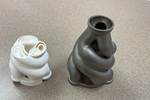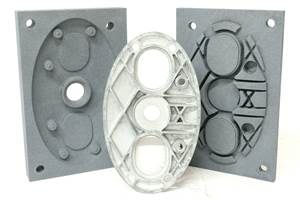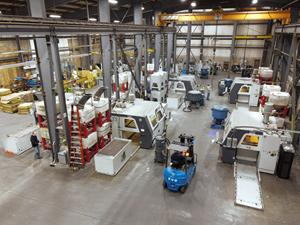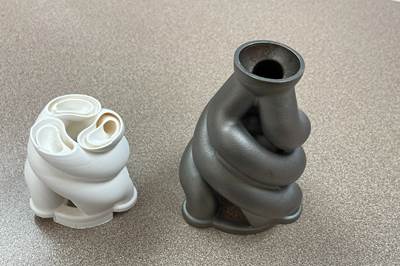Share
Read Next
I had the chance to visit Skuld LLC in Springfield, Ohio, to learn about the startup company’s patent-pending 3D printing-enabled process known as Additive Manufacturing Evaporative Casting (AMEC). This process provides a new approach to lost foam casting (LFC), a type of investment casting, and additionally it extends the application range of this metal part making process.
From left to right, the above image depicts the original 3D printed pattern and the completed metal part (made via AMEC process) side by side. While at Skuld, I had the opportunity to look at these pieces to better visualize how 3D printing lends itself to the AMEC process.
I met with Skuld LLC’s CEO, Sarah Jordan, and Chief Technical Officer, Mark DeBruin, to tour their facility and learn how AMEC compares to traditional lost foam casting.
It is important to note, Skuld LLC is in the process of expanding its operations via a new facility in Piqua, Ohio.
Skuld is now primarily operating out of this new facility, and the company plans to officially close its Springfield doors come June 2024.
What Is Lost Foam Casting?
Let’s begin with the question that was on my mind when I first journeyed to Skuld. What is lost foam casting? In order to understand Skuld’s AMEC process, it is valuable to understand the process on which it is based.
LFC is a form of evaporative casting, utilized primarily for making large-quantity metal parts. The approach offers an effective production option for parts requiring good surface finishes as well as tight tolerances.
The process is best for high volumes because it relies on consumable foam (polystyrene) patterns made in a mold — and the mold tooling represents a significant up-front expense. Moldmaking is essentially “step zero” in the process. Once mold tooling is available, the process involves the following six steps:
- Create foam (polystyrene) pattern via molding
- Assemble cluster of patterns to gating system
- Apply a ceramic coating and allow this to dry/harden
- Place this coated cluster of patterns into a flask, pack with sand particles or ceramic beads for support and then compact
- Pour in the molten metal to vaporize the foam
- Shake out and finish to obtain the metal component
Thus, LFC produces intricate metal components as the foam evaporates and the molten metal flows into its place.
LFC permits complex designs with features generally considered challenging for casting, including zero or alternating draft, internal channels, blind holes and cast threads. In addition, the net shape often requires zero machining or machining only for features such as tapped threads or precise sealing surfaces.
Additionally, lost foam casting is a sustainable method of making metal parts as it enables the recycling of scrap metal (for example, from the gating) to produce future cast parts.
LFC typically doubles the yield (amount of metal poured to the amount of finished castings) over other forms of casting, which can save energy, green house gasses and more.
Skuld LLC has been working to crack the code to bring these benefits to lower volume production. Its patent-pending AMEC process does this, in part, by replacing foam patterns with hollow 3D printed forms.
The company’s AMEC process has been in the works since 2015 and was originally developed to eliminate the tooling expenses associated with lost foam casting. AMEC is appropriate for both small and medium volumes, but can also be utilized for high volumes to bridge the lead time needed to produce tooling.
This image captures Mark DeBruin, Skuld LLC’s chief technical officer, as he tends to a metal part in one of Skuld’s regular kilns which it was using at the time to make some R&D parts. In the AMEC process, however, the part is put into the furnace intentionally created for the Lightning Metal system.
The AMEC process is now available on the market and employs 3D printing on a low-cost, desktop polymer machine as the key to the elimination of tooling. And, this resource brings other advantages as well. Before we dive into the steps of the AMEC process, let’s first consider how 3D printing works to the process’ advantage.
Skuld utilizes 3D printing in AMEC to:
- Produce parts as needed at point-of-use
- Generate the exact quantity of each part needed rather than in larger, minimum batch sizes (simultaneously reducing costs)
- Enable less inventory on shelves
- Eliminate the cost and time of obtaining tooling by making a pattern directly
- Enable highly complex shapes and geometries of intended parts not feasible with mold tooling
- Permit part consolidation
- Offer lightweighting via lattices and topology optimization
AMEC Technology and Process
The system consists of more than this. Along with employing 3D printing as the pattern source, it incorporates the other lost foam casting steps into low-cost hardware stations. Skuld LLC offers its AMEC technology through a system called Lightning Metal 16, which automates or simplifies the AMEC process.
The standard system is designed for parts with a seven-inch-cube envelope that weigh less than 10 pounds. The technology, however, can be configured to accommodate sizes beyond this. These are the steps:
From left to right, this image depicts a finished fin heat exchanger (made via Skuld LLC’s AMEC process) and next to it, the original 3D printed pattern (clear).
-
Print. The 3D printer provided comes with material filament (typically PLA) that is suited to melting without harmful gasses in the lost foam process. Minimal material is used because 3D printed patterns need as little infill as is practical.
-
Prep. Foam gating is attached to the 3D print. These are taken to the Coat1 unit, where a thin ceramic coating flows over the print and gating, and dries. The foam and 3D print pattern are then set in a flask. Ceramic beads are poured over it to fill the flask, settled with vibration.
This photo shows the prepped flask that Skuld improvised as it was making something bigger than the normal flask size. The company is still working on building the full production line which will have 36- inch flasks as standard. The black cylinder on the floor behind the large flask is actually the Lightning Metal flask. The device behind it is the furnace for the Lightning Metal system (without the housing to contain the full system).
-
Pour. The prepped flask is then loaded into the compact Lightning Metal furnace, which melts the metal and pours it into the pattern. The pattern is “lost,” replaced by the metal part. When the flask is cool (this usually takes two hours), the flask can then be removed, and the metal part is removed as well.
AMEC Benefits
The process requires 3D printing, but it is a variant of lost foam casting and has all of this process’ benefits. These include:
- In comparison to sand casting, AMEC offers improved surface finish and tolerances, reducing the need for postprocessing.
- Relative to lost wax investment casting, AMEC is more affordable, offers a faster process time and enables geometries such as internal channels that are difficult to obtain in traditional investment casting.
- In comparison to direct printing, AMEC delivers a cast microstructure with conventional properties.
The AMEC process simply delivers all this without any need for tooling. Via this process, precision casting is more accessible, practically any manufacturer can operate the equivalent of a miniature foundry and anyone who knows how to 3D print has the starting point to apply the lost foam process — no toolmaking is required.
Related Content
How Machining Makes AM Successful for Innovative 3D Manufacturing
Connections between metal 3D printing and CNC machining serve the Indiana manufacturer in many ways. One connection is customer conversations that resemble a machining job shop. Here is a look at a small company that has advanced quickly to become a thriving additive manufacturing part producer.
Read MoreFoundry Lab: How Casting in a Day Will Improve the Design of Metal Parts (Includes Video)
The company’s digital casting process uses 3D printing, but the result is a cast part. By providing a casting faster than a foundry, the company says effective prototyping is now possible for cast parts, as well as bridge production.
Read MoreEaton Evaluates Foundry Lab Process as Die Cast Alternative: Aids Prototyping and Supply Chain
Foundry Lab’s digital casting is an additive-enabled process that delivers cast parts. Eaton AM manager describes how near to die casting the process comes, and what promise he sees.
Read MoreLooking to Secure the Supply Chain for Castings? Don't Overlook 3D Printed Sand Cores and Molds
Concerns about casting lead times and costs have many OEMs looking to 3D print parts directly in metal. But don’t overlook the advantages of 3D printed sand cores and molds applied for conventional metal casting, says Humtown leader.
Read MoreRead Next
Casting With Complexity: How Casting Plus 3D Printing Combine the Strengths of Both
Aristo Cast is advancing a mode of part production in which casting makes the part, but 3D printing enables the geometry.
Read MoreLooking to Secure the Supply Chain for Castings? Don't Overlook 3D Printed Sand Cores and Molds
Concerns about casting lead times and costs have many OEMs looking to 3D print parts directly in metal. But don’t overlook the advantages of 3D printed sand cores and molds applied for conventional metal casting, says Humtown leader.
Read MoreAlquist 3D Looks Toward a Carbon-Sequestering Future with 3D Printed Infrastructure
The Colorado startup aims to reduce the carbon footprint of new buildings, homes and city infrastructure with robotic 3D printing and a specialized geopolymer material.
Read More

























